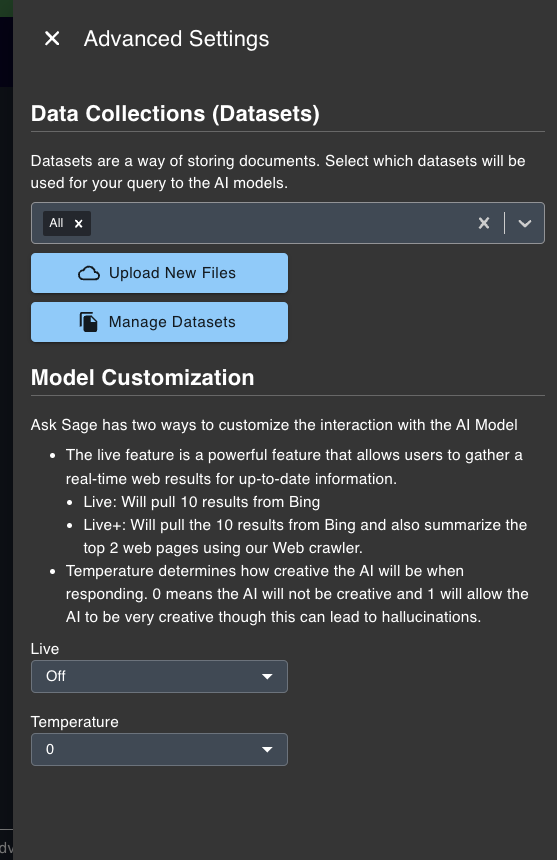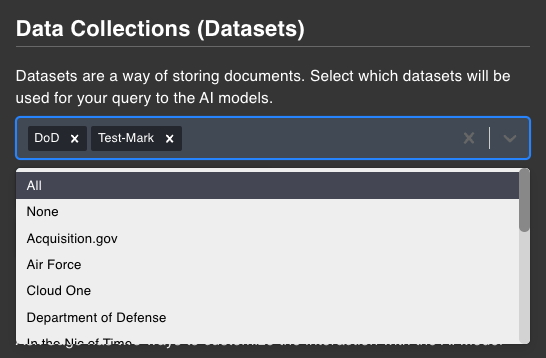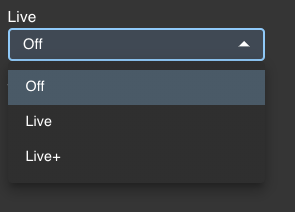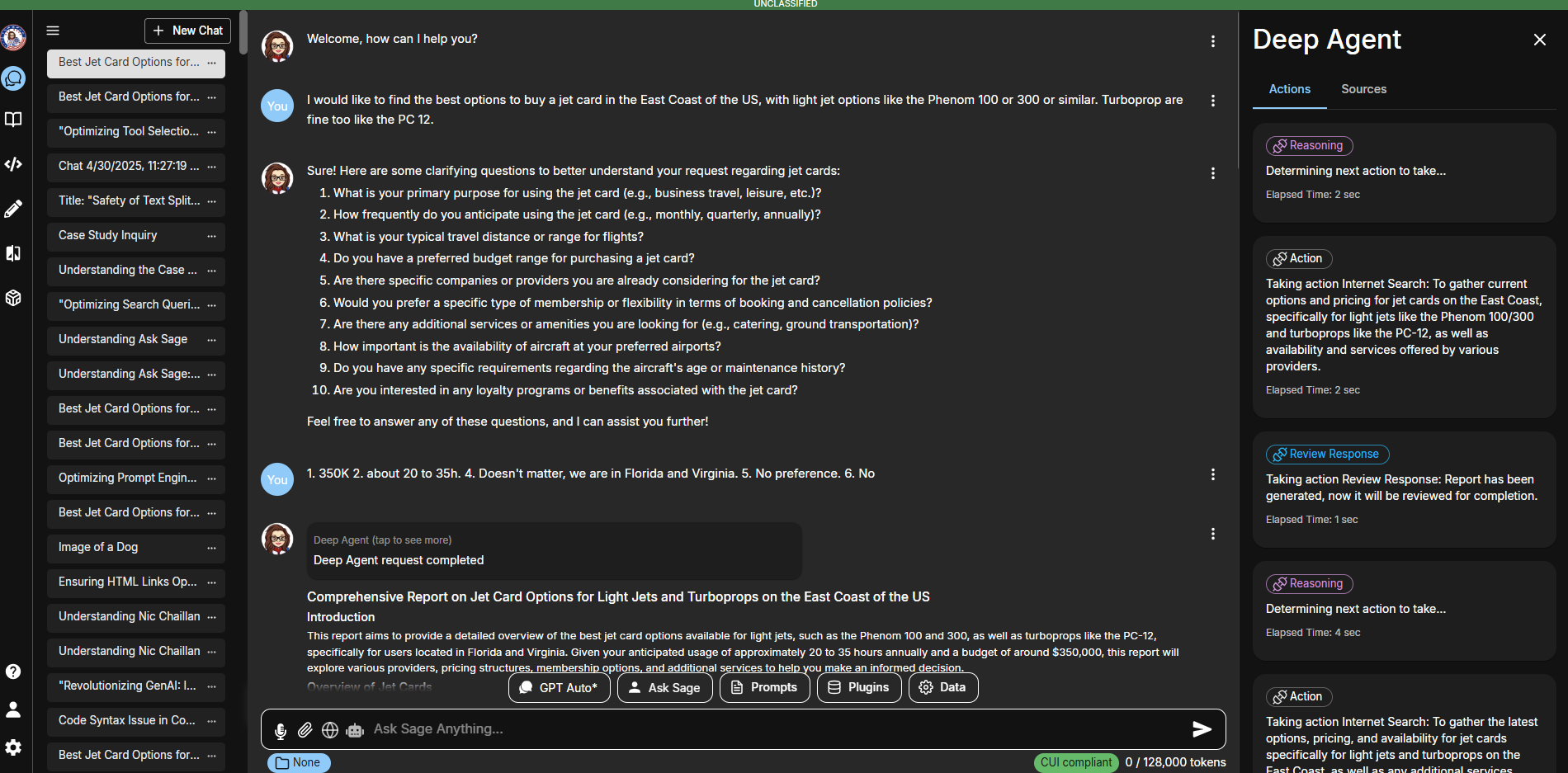Data & Settings, Deep Agent, & MCP
To optimize the results for your specific use case, we will explore the different features available to users on Ask Sage. These features can be adjusted for each prompt to generate the best possible outcomes.

Table of contents
Data & Settings

Ask Sage Datasets
Dataset selection is also available via the Data & Settings button. Select one, multiple or all the datasets you want the prompt to reference and generate text from.
To learn more about creating datasets, please refer to the Dataset section of the documentation.

How Does it Work?
The dataset feature in Ask Sage Chat enables users to select one or multiple datasets. This process utilizes Retrieval-Augmented Generation (RAG) to extract the most relevant information from the chosen dataset(s) and generate responses based on that data.
What is RAG?
RAG enhances the GenAI process by retrieving pertinent external context and integrating it into the original prompt. This involves two key steps:
- Retrieve Relevant Context: This step gathers additional data related to the task at hand.
- Augment Prompt with Retrieved Data: This step incorporates the gathered information into the prompt, enriching the input for more accurate and informed outputs.
Users have the flexibility to create their own datasets within the platform. What sets Ask Sage apart is that it allows users to utilize their datasets with any model of their choice, ensuring that they are not confined to a specific model.
When datasets are created, they can be classified as either Unclassified or CUI. Other tenants may offer additional classification options.
Note: To utilize the CUI label, users must possess a CAC/PIV card or request activation for CUI classification if you do not have a CAC/PIV Card. To request this feature, please email support@asksage.ai. (Access is not granted automatically and follow on instructions will be provided to you via email.)
To optimize response generation time, we recommend selecting only the dataset(s) necessary for your prompt. If you do not need to reference any dataset, you can simply choose the none option.
Web Search
The Web Search feature can be accessed via the Data & Settings button, offering three options: off, Live, and Live+. By default, the live feature is set to off. When the Web search toggle is activated, it automatically switches the live feature to Live+ mode.

Live: Will pull 10 results from GoogleLive+: Will pull the 10 results from Google and also pull the top 2 web pages summaries using our Web crawler.
The Live feature is not CUI/Sensitive data compliant as it is using a Search Engine to pull information from the web, and we can not control what information is being collected by the search engine.
Temperature
The temperature parameter is available via the Data button.
Adjust the temperature of the model. By default, the temperature is set to 0.0.
The temperature parameter regulates the randomness of the model’s responses. A lower temperature results in more deterministic and consistent outputs, while a higher temperature introduces greater variability and creativity. Consequently, while a higher temperature can lead to more imaginative responses, it may also result in less coherent or structured outputs.

We recommend using a temperature of 0.0 for most use cases, as this will provide the most accurate and relevant results. However, if you are looking for more creative or varied responses, you can increase the temperature to 0.5 or 1.0.
Deep Agent
Deep Agent: Unlocking Advanced Research with Ask Sage
We are thrilled to introduce Deep Agent, a groundbreaking feature in the Ask Sage GenAI platform. Deep Agent is the first AI agent capable of conducting searches across both the web and your secure datasets, including Retrieval-Augmented Generation (RAG) sources. This innovation empowers users to perform advanced research and analysis with unprecedented ease and precision.

How Deep Agent Works
Deep Agent leverages advanced AI agents to iteratively perform complex research tasks. It automatically generates queries and prompts, seamlessly exploring the web, your private datasets, or both. This capability enables users to uncover deeper insights and achieve higher productivity.
Deep Agent is ideal for users who need to combine public and private data sources for comprehensive research. Whether you’re analyzing trends, generating reports, or solving complex problems, Deep Agent simplifies the process.
Token Usage Guidelines
Each Deep Agent query initiates multiple prompts, which can consume a significant number of tokens. To optimize your experience, select your models carefully. By default, Deep Agent uses the 4o model, which balances cost-effectiveness and performance.
The 4o model is a great starting point for most users. However, if you require higher precision or specific capabilities, you can select a different model from the available options.
Token Consumption Example:
- A single Deep Agent query may generate dozens of prompts, depending on the complexity of the task.
- For example, a query analyzing both web and RAG data might consume 500–1,000 tokens per session.
Beta Mode: Continuous Improvement
Deep Agent is currently in beta mode, and we are actively refining its performance. Your feedback is invaluable in helping us improve results and enhance automation.
As this feature evolves, we recommend testing it with various use cases to explore its full potential. If you encounter any issues or have suggestions, please contact us at support@asksage.ai.
Model Context Protocol (MCP)
The Model Context Protocol (MCP) is a powerful framework designed to enable seamless interaction between users and AI models. MCP provides a structured way to define, manage, and execute actions or tools within a given context. By leveraging MCP, users can extend the capabilities of AI models to perform specific tasks, automate workflows, and integrate external systems or APIs.
To learn more about MCP, please refer to the Model Context Protocol (MCP) documentation.